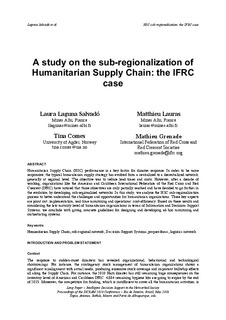A Study on the Sub-Regionalization of Humanitarian Supply Chain: the IFRC Case
Chapter, Peer reviewed
Permanent lenke
http://hdl.handle.net/11250/2436443Utgivelsesdato
2016Metadata
Vis full innførselSamlinger
Originalversjon
Tapia, Andrea H.; Antunes, Pedro; Banuls, Victor A.; Moore, Kathleen; Porto, Joao [Eds.] Proceedings of the 13th International Conference on Information Systems for Crisis Response and Management, Federal University of Rio De Janeiro, 2016Sammendrag
Humanitarian Supply Chain (HSC) performance is a key factor for disaster response. In order to be more responsive, the typical humanitarian supply strategy has evolved from a centralized to a decentralized network, generally at regional level. The objective was to reduce lead-times and costs. However, after a decade of working, organizations like the Americas and Caribbean International Federation of the Red Cross and Red Crescent (IFRC) have noticed that those objectives are only partially reached and have decided to go further in the evolution by developing sub-regionalized networks. In this study, we analyse the HSC sub-regionalization process to better understand the challenges and opportunities for humanitarian organizations. Three key aspects are point out: implementation, real-time monitoring and operations’ cost-efficiency. Based on these results and considering the law maturity level of humanitarian organizations in terms of Information and Decision-Support Systems, we conclude with giving concrete guidelines for designing and developing ad-hoc monitoring and orchestrating systems.
Beskrivelse
-
